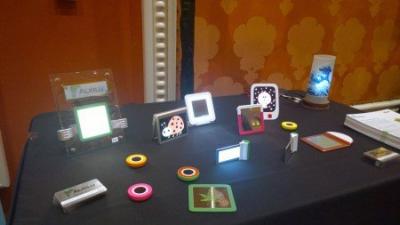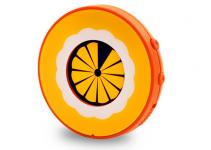 Alkilu, a new company established in 2013 to develop affordable consumer OLED lighting devices, unveiled their range of OLED products at CES 2014. And these indeed are affordable - some of those OLED lamps cost as low as $19.95.
Alkilu, a new company established in 2013 to develop affordable consumer OLED lighting devices, unveiled their range of OLED products at CES 2014. And these indeed are affordable - some of those OLED lamps cost as low as $19.95.
The company's CEO, Alex Khayat, was kind enough to answer a few questions we had regarding the company and those OLED lighting devices. Alex has 25 years of technology experience, including nearly a decade of OLED industry R&D for Boston-based ieDisplay (an R&D company that sold its research to tech specific and similar companies).
The name Alkilu, by the way, comes from two origins the first 3 letters of the name come from the Alq3 compound (or Aluminium tri-quinoline or pronounced as ALK3) which is the common component of OLEDs and the last 3 letters (ILU) comes from ancient times and stands for "power".
Q: First of all, please tell me a bit about Alkilu, what's your vision and targets long term. Will you also get involved with the OLED technology itself?
Our belief is that OLED technology can and should be a part of everyday life. Right now, the average consumer is just becoming aware of OLEDs, but they are seeing products way out of their price range. We’re going to change that. Once the consumer fully realizes the unique traits and benefits of OLEDs and sees them available at a reasonable price the game is going to change in the consumer lighting space in a major way.

At this point, our focus is really on developing partnerships with both designers and manufacturers. We’re naturally very interested in the advancements of OLED technology itself specifically as it relates to flexible lighting products and that advancement is happening with both groups at the moment.
Q: Can you say why did you choose to base your lighting products on OLEDs?
Almost entirely for their unique attributes. They can be flexible, transparent and adapt to almost any form factor. They are generally far more efficient and eco-friendly. The potential is amazing, particularly as a synergistic technology with LED, as it provides us with lighting designs & innovations very difficult and inefficient with LEDs. We were never interested in joining a crowded market for other lighting sources. For us, it was always about OLED and the potential it represents.
Q: Do you use OLEDs as a marketing advantage? Do you think consumers are aware of this lighting technology and will be willing to pay a premium for it?
Yes, no and yes. We are definitely using the OLED attributes I just mentioned as a marketing tool. Of course the challenge is that most consumers are not familiar with it, but if we’re successful, consumers will not only know about the benefits of OLEDs, they’ll actually prefer them to other forms of lighting.
A key focus of our go-to market strategy will be around creating high demand for a high-quality product that can compete with LED-based products on form, function, and especially, price. This is not to say that we won’t be selling higher-end merchandise, but comparative to other lighting products, those too will be considered affordable. We think that OLEDs can follow a similar adoption path as LEDs saw not too long ago, relatively speaking.
Q: You list very affordable prices on your site (as low as $19.95 for some OLEDs). Can you explain how did you manage to secure low cost OLED panels? As far as I know even the most simple bare OLED panels cost more than that. In fact I believe the cheapest OLED lamps available today besides cost over $500.
Yes, you are correct and that is what we are trying to change. These are indeed the same high quality OLED panels. Our market research has shown that our best pricing strategy would be to be in line with LED-based products, without losing quality of course. Our solid partnerships with the different manufacturers/suppliers allows us to negotiate on volume discounts and capabilities to stay competitive. As many of your readers will recall, a similar strategy was used when LEDs were just starting out. We feel OLED needs that push to become mainstream and we hope to be the ones that jumpstart the process.
 |  |  |
Q: Back at CES you promised to release the first products by April or May. Is that still on track?
We will actually be launching a few of the products sooner, around the March timeframe, and around the May timeframe for the remaining items.
Q: Your OLEDs are currently not very efficient (20 lm/W). Do you think that is acceptable today? Do you have plans for more efficient panels?
Our current products range from 40lm/W all the way up to 80lm/W. However, depending on the product line and its requirements, we have optimized some of the OLEDs to fit the solution to promote longer life and operating time. Certain product lines, such as our upcoming transparent bookmark product, would not require a high lumen output as it defeats its purpose to minimally light the reading area, so a balanced configuration is developed for optimal operation. In other cases, such as our newly designed All-Terrain light, it could easily be configured for high lumens as its requirements demand it.
Q: In your site you say that you use several suppliers. Can you name some of these? There are not many suppliers that can actually produce meaningful volumes, let alone those structured OLEDs you showcase on the site (such as the LadyBug lamp, etc.).
We will be happy to provide the suppliers in the coming months as we finalize our contracts, but for now, all we can say is that they are primarily in Europe and Asia.
Q: Where do you see OLED lighting in the next 3-5 years?
Everywhere! With the advent of OLED technology advancements, as well as a push by LG and Samsung, we feel a lot of new changes are coming, specifically around flexible lighting. Each year we see great improvements in OLED lighting technology and feel both polymer and quantum dot OLED technologies would streamline. We’re excited to be a part of this development.
Thanks Alex! I wish both you and Alkilu the best of luck, and I hope to see you launch those beautiful OLED devices soon!

